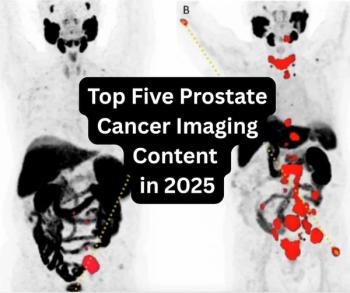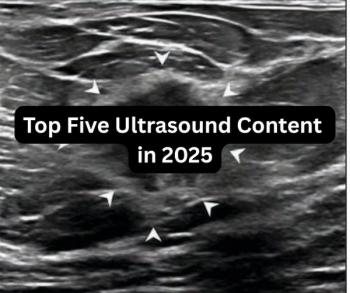A new meta-analysis demonstrates superior sensitivity for the use of the fibroblast activation protein inhibitor (FAPI) in positron emission tomography (PET) across a range of primary gastrointestinal tumors and metastases in comparison to fluorodeoxyglucose (FDG) PET.
For the meta-analysis, recently published in Academic Radiology, researchers reviewed findings from 16 studies and a total of 597 patients. The studies included nine publications on gastric cancer and four studies on colorectal cancer, according to the meta-analysis.
The meta-analysis authors found that (68Ga)Ga-FAPI-04 PET provided 98 percent sensitivity and 93 percent specificity for primary gastric cancer tumors in comparison to 74 percent sensitivity and 48 percent specificity for (18F)FDG PET.
For lymph node metastases in patients with gastric cancer, the researchers noted that (68Ga)Ga-FAPI-04 PET had double the sensitivity of (18F)FDG PET (90 percent vs. 45 percent) and 10 percent higher specificity (93 percent vs. 83 percent).
“In gastric cancer, (68Ga)Ga-FAPI-04 exhibits superior sensitivity, specificity and semiquantitative metrics compared to (18F)FDG in both primary gastric tumor and metastases, particularly in specific pathological types, such as SRCC (signet-ring-cell carcinoma),” noted lead author Yuxuan Zhao, M.D., who is affiliated with the Department of Nuclear Medicine at the First Hospital of China Medical University in Liaoning, China, and colleagues.
The meta-analysis findings revealed that (68Ga)Ga-FAPI-04 PET was associated with a 53 percent higher sensitivity than (18F)FDG PET for gastric signet-ring-cell carcinoma (GSRCC) (99 percent vs. 46 percent).
Three Key Takeaways
1. Superior diagnostic performance. (⁶⁸Ga)Ga-FAPI-04 PET showed significantly higher sensitivity (98 percent) and specificity (93 percent) for detecting primary gastric cancer tumors compared to (¹⁸F)FDG PET (74 percent sensitivity, 48 percent specificity).
2. Improved detection of metastases. For lymph node metastases in gastric cancer, (⁶⁸Ga)Ga-FAPI-04 PET demonstrated double the sensitivity (90 percent vs. 45 percent) and higher specificity (93 percent vs. 83 percent) than (¹⁸F)FDG PET.
3. Notable advantage in SRCC. In gastric signet-ring-cell carcinoma (GSRCC), (⁶⁸Ga)Ga-FAPI-04 PET achieved a markedly higher sensitivity (99 percent) compared to (¹⁸F)FDG PET (46 percent), attributed to increased FAP expression in the tumor stroma.
“This could be explained by the low density of tumor cells, the high quantity of inert mucus components, and the comparatively low expression of the glucose transporter 1 (GLUT-1). The abundant tumor mesenchyme in advanced SRCC occupies the majority of the tumor mass, and many CAFs (cancer-associated fibroblasts) within the tumor stroma overexpress FAP, resulting in increased uptake of (68Ga)Ga-FAPI-04 in SRCC,” posited Zhao and colleagues.
For gastrointestinal cancers, the researchers found that (68Ga)Ga-FAPI-04 PET offered 17 percent higher pooled sensitivity for primary tumors (99 percent vs. 82 percent) and 39 percent higher pooled sensitivity for metastatic lymph nodes (95 percent vs. 56 percent).
(Editor’s note: For related content, see “Study Shows Benefits of mpMRI Over Dual-Energy CT for Gastric Cancer Staging,” “Consensus Recommendations on MRI, CT and PET/CT for Ovarian and Colorectal Cancer Peritoneal Metastases” and “Can CT-Based AI Provide Automated Detection of Colorectal Cancer?”)
In regard to limitations of the meta-analysis, the authors acknowledged that eight of the reviewed studies were retrospective and emphasized the need for larger multicenter prospective studies in the future.





























